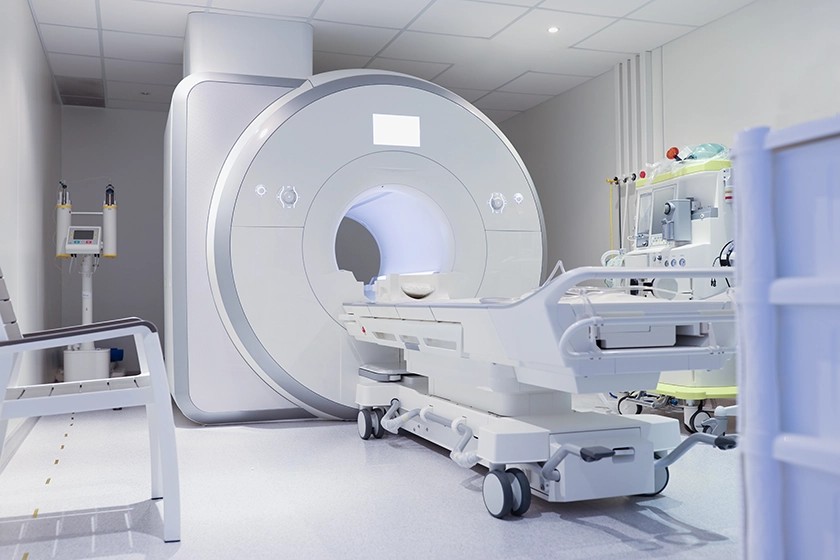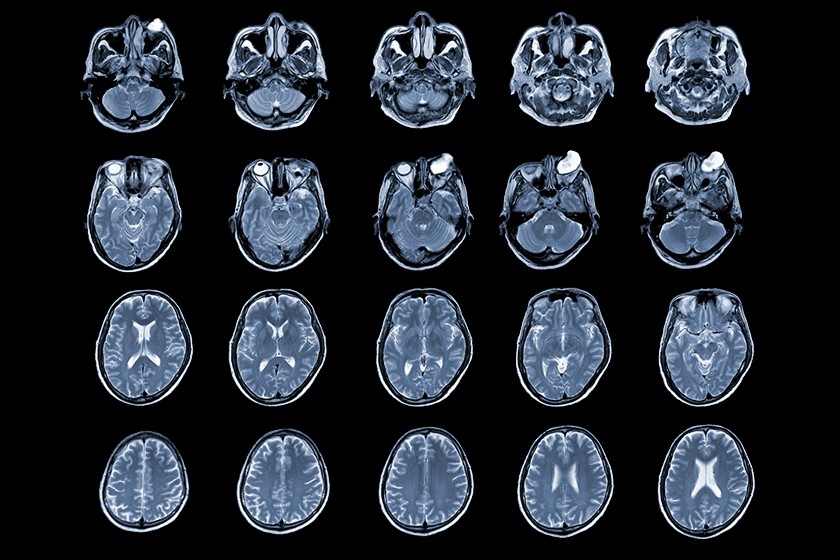My Immune System is an Asshole
MS Chronicles
I Survived Another MRI: Where’s My Trophy?
Let's talk about MRIs—the loud, claustrophobic rite of passage every MS patient knows all too well. Sure, they're necessary, but that doesn't make them any less absurd. So, grab your grippy socks (we'll get to those later), and let's dive into the chaotic world of MRIs, why they matter, and why you absolutely deserve a medal for enduring them.
MRI 101: What Is It and Why Do We Need It?
MRI stands for Magnetic Resonance Imaging, which is just a fancy way of saying giant magnet tube that takes pictures of your insides. For MS patients, these delightful scans are essential for tracking disease progression, spotting new lesions, and figuring out if your treatment is actually doing anything—or just making your wallet lighter.
Here's the science-y part: the machine works by lining up all the hydrogen atoms in your body (yes, you're mostly water—shocking, I know) and then zapping them with radio waves to knock them out of place. When the atoms snap back into position, they release signals that the MRI turns into detailed images of your brain, spine, and whatever else MS has decided to mess with lately.
Fascinating, right? No? Yeah, I'm yawning too. Let's just say it's a pricey way to find out what you already know: your immune system is still an traitorous asshat.
Common Areas Imaged for Multiple Sclerosis
If you've got MS, you're likely all too familiar with these standard MRI targets:
Brain:
This is usually the first stop in diagnosing and monitoring MS. Lesions often appear in (but are not limited to) areas like the:
- Periventricular area: Around the brain's ventricles. These are hallmark MS spots, often forming Dawson's fingers.
- Corpus callosum: The bundle of nerves connecting the brain's hemispheres.
- Brainstem: Responsible for basic functions like breathing and heart rate, it's a critical area often affected by lesions.
- Cerebellum: Involved in balance and coordination, making it a common culprit for MS-related clumsiness.
Cervical Spine:
This is the neck portion of your spine, where lesions can lead to arm weakness, numbness, or the infamous "MS hug." The cervical spine is a hotspot for spinal cord lesions because of its proximity to the brain and its role in transmitting nerve signals.
Thoracic Spine:
The upper to mid-back section of your spine. Lesions here can cause leg weakness, numbness, and bowel or bladder issues. This area is often imaged if you're experiencing these specific symptoms.
Lumbar Spine:
The lower back, or lumbar spine, is an area where MS lesions are rarely found because the spinal cord itself ends around the L1-L2 vertebrae. This area is more commonly imaged for non-MS issues, like degenerative disc disease (DDD). When imaging for DDD, they're typically looking for herniated discs, compressed nerves, bone spurs, and narrowed spacing between vertebrae (spinal stenosis). These delightful conditions can cause chronic lower back pain, sciatica, or reduced mobility—and while they may not be MS-related, they're still a pain in the ass (literally and figuratively).
Now, is the lumbar spine super relevant for MS? Not really. But I have DDD, so suck it—it's relevant to me. Think of this as the carnival of medical imaging, where you pay out the ass for rigged games and walk away with cheap prizes like "compressed nerves" and "chronic pain." The MRI might not hand you a stuffed animal, but it will give you a printout of all your body's new and exciting ways to fail you. And just like a carnival, you can't leave without wondering why you spent so much for something that feels so utterly exhausting.
What Does Contrast Do, Anyway?
Ah, contrast—the magical potion they inject to make your lesions light up like a Christmas tree. It's used to identify active inflammation, which is crucial for understanding whether your MS is behaving or throwing another tantrum.
Sure, it feels weird, and no one likes the metallic taste that sneaks into your mouth afterward, but the real kicker is the sensation it can create. As the contrast spreads through your body, it often causes a sudden warm, tingly feeling in your lower abdomen and pelvis that makes you think, "Ah for fucks sake, did I just piss myself?" Don't worry—you most likely didn't. Your MS isn't staging a public bladder coup (this time). It's just one of those weird, harmless side effects that comes with the territory of having dye pumped through your veins. Awkward? Sure. But hey, at least it's better than leaving your neuro guessing about what's going on in there.
Brain Volume Tests
Did you know that MRIs can also measure your brain volume? It's an excellent way to monitor long-term changes and catch signs of accelerated shrinkage (atrophy) early. Most neurologists probably will not order a brain volume test unless they are MS specialists but it should be part of your annual MRI routine. Ask your neurologist to add it to the MRI order. When I asked my first neurologist for a brain volume test, she stared at me like I'd just introduced her to running water. But hey, being informed sometimes means challenging the status quo.
Why does Metal and Tattoos Matter?
Here's the deal: That giant magnet in the MRI machine is no joke. If you have metal implants—like pacemakers, joint replacements, or even some dental work—the MRI Tech needs to know. The magnet can heat, move or even rip out metal objects in your body, which is as dangerous as it sounds.
Tattoos are another consideration. Older inks, especially those with metallic components, can heat up during an MRI and cause discomfort or even burns. While this is rare, it's worth mentioning to the technician if you've got any ink. And yes, they'll probably roll their eyes at you, but better safe than sorry!
Headphones or Earplugs?
The Grippy Socks Experience
Let's talk about the grippy socks—those non-slip, undersized wonders that somehow manage to be both too tight and too loose at the same time. They're the height of medical chic, offering all the comfort of a soggy tortilla wrapped around your feet. Stylish? Hardly. Necessary? Debatable. But hey, nothing says "I'm ready for this MRI" like shuffling around the waiting room in socks that scream, 'patient zero.'
And while we're at it, can we talk about the hospital gown situation? It's 2025—why are we still rocking these glorified potato sacks with strings you can't tie without sprouting an extra arm? You're already dealing with the humiliation of being poked, prodded, and shoved into a machine that sounds like a rave gone wrong. Do we really need the added joy of your ass hanging out every time you stand up? Surely, someone out there can invent a gown that doesn't double as a fabric-based exercise in humiliation.
Between the grippy socks and the ass-out gowns, the whole experience feels less like a medical necessity and more like a poorly executed prank. But hey, at least you're dressed for the part… if the part is escaped mental hospital patient.
MRI Tech's Won't Spill the Beans
But here's a pro tip: on your way out, swing by the records office and request a copy of your MRI images and the radiologist's report. It's always a good idea to have your own copy in case you decide to change neurologists or need a second opinion. Just know that the images will likely come on a CD, and no, they aren't your typical JPEGs that you can just pop into your computer. You'll need a DICOM viewer app to see them.
Luckily, there are a few free DICOM viewers available for both Mac and PC. They're easy to use and let you dive into your images—because let's face it, you're going to want to see what your brain or spine looks like while you wait for your Neurologist to get the results and look them over. Plus, it's oddly satisfying to scroll through and feel like a radiologist for five minutes (even if you have no idea what you're looking at).
Why You Deserve That Trophy
Enduring an MRI isn't just about lying still; it's about surviving the absurdities—the loud noises, the awkward music options, the claustrophobia (when you tell them you're not claustrophobic but start to question if you really aren't once you're in the tube) and the endless waiting for results. It's a test of patience and resilience that no one signed up for but every MS warrior faces like a champ.
So, where's the recognition? A sticker, a medal, or maybe even a trophy that says, "I survived another MRI without punching someone"? Because if we're going to keep doing this year after year, we might as well get some credit for it.
Fun Fact...
Ever notice how MRI machines are always tucked away on the bottom floor or in the basement of a hospital? That's because these machines are heavy. The average MRI machine weighs between 10,000 and 15,000 pounds. Most buildings aren't designed to support that kind of weight, so they're installed on ground-level or reinforced areas to keep the whole structure from collapsing. So, the next time you're trudging down to the basement for your scan, just remember: it's not because they're trying to hide the MRI—it's because nobody wants a 15,000-pound machine crashing through the ceiling.




